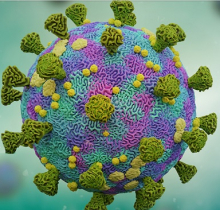When a new and deadly coronavirus began to sweep across the world earlier this year, researchers from the UW’s Department of Physics, the University of Hong Kong and other institutions quickly assembled a team to learn how B cells — a central player in adaptive immunity — were engaging this enemy.
With about 10 billion B cells circulating in the human body at any given time constantly searching for invaders, that’s no easy task, said the UW’s Zach Montague, one of the team’s principal collaborators. Each one of these B cells is unique, with a Y-shaped receptor capable of coupling to a specific antigen from an invading virus or bacteria.
But that’s just in one person, Montague said. Each person makes very different and diverse antibodies, even against the same virus. Finding a B cell that can be enlisted to fight COVID-19 across an entire population is literally like finding a single unique grain of sand among the grains that cover all the beaches in the world.
Read more at UW-IT.
